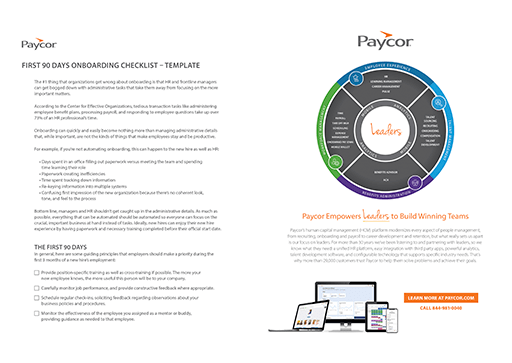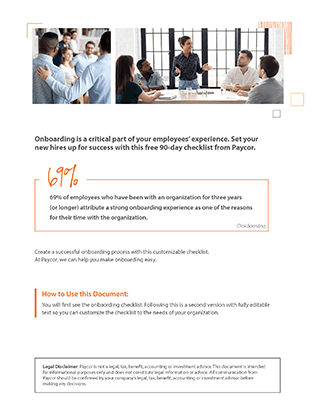One Minute Takeaway
- 69% of employees with a strong onboarding experience stay for 3+ years
- A 30-60-90 day plan for onboarding sets up new hires for success.
- An onboarding checklist ensures that key information is transferred at the right time.
In a recent Gallup survey, only 12% of employees felt their organization did a “great” job of onboarding. That could be because many companies have an abbreviated onboarding process that gets a new hire in the door, familiar with the systems and then…nothing.
A lot of organizations base the lack of planning on two assumptions; the first is that the new hire will be able to start being productive immediately; and the second is that the new hire will stay with the organization for an extended period of time.
However, with a more strategic onboarding plan, you can put your new hire in a strong position for work that’s successful, not filled with guessing games. More specifically, a 90-day plan for onboarding helps not just the new hire get acclimated to the organization but it helps the organization become familiar with the new hire.
Success in Planning
It’s not a secret that success takes planning. You wouldn’t launch a new product or open a new branch location without an action plan in place with measurable goals for success. Hiring a new team member should come with the same amount of focus and planning.
A 30-60-90 day plan can help a hiring manager set goals by providing both the employee and leadership team with an actionable path and targets that can be measured against as the employee grows into their role within the company. Those can be built against predetermined concrete goals and achievable objectives which are spelled out in the checklist. These objectives include ensuring your team member:
- Has everything they need to be successful from day one
- Understands the expectations of their role and responsibilities
- Aligns to how they, as individuals, impact the team/department/company objectives
A Checklist Helps Everyone Stay On-Task During Onboarding
Everyone has had that one job where most of their onboarding time was spent listening to veterans of the organization share stories of how they used to do things with a nod to what’s happening today. It’s interesting, but is it an effective way of helping a new hire understand internal processes?
One way to keep everyone on-point is with a checklist. This helps the new hire know what they should be doing, learning and it helps other employees know where their help and knowledge is needed.
Flexibility Can Equal Success
It’s important to remember that often things don’t go exactly according to plan. So much of an onboarding program is reliant on other people (to accept meetings, to provide information, to set systems) that it can be overwhelming to accomplish in a few days, or it can be almost impossible. But, with a 90-day plan and checklist for onboarding, flexibility is built-in. Established checkpoints help get leadership guidance and support; and, there is a greater opportunity for accomplishment.
The Secret to a Fulfilling Onboarding
An effective 30-60-90 day plan for onboarding does more than connect the dots of a physical workday (go here for IT help, the cafeteria is there, talk to that team for supplies), it sets the tempo of the position and strengthens the character of the organization. All of those things you told the candidate about the organization during the hiring process should be seen in the onboarding period.
69% of employees who have been with an organization for three years (or longer) attribute a strong onboarding experience as one of the reasons for their time with the organization.
Don’t just make onboarding about what the new hire needs to get started, consider what they need to be successful across their career.
Using a Checklist to Manage Pre-Boarding
Successful onboarding doesn’t start on day one, it has to start sooner so those first few days at the desk are productive. In the past, pre-boarding encapsulated all of the work that a hiring manager had to do in regards to tax documents, systems set up, finding a desk, etc. More and more organizations though are using this as a period to start to build engagement.
- Give them their position and project background materials so that on day one they have a baseline level of knowledge. This helps them to feel like they can contribute immediately. It also helps them to contextualize many of the conversations they may be a part of.
- Allow them to see their full onboarding plan early. It helps them prepare and instills a sense of confidence that they won’t be jumping into a new role without support.
- Use the checklist to set their first week’s activities.
How Should an Onboarding Checklist Be Used?
More than half of all organizations who responded to a recent survey said the focus of their onboarding programs are paperwork and processes. Need help streamlining paperwork? Paycor has an onboarding program built just for that.
Yes, there are numerous documents that a new hire has to sign but the onboarding process needs to be about more than capturing tax deductions and insurance decisions. A checklist will help you to make sure that throughout the onboarding process, there are “tasks” that:
1. Increase socialization
Socialization should be a huge part of the onboarding process. The new team member wants to meet all of their team members and key stakeholders but not just to say “Hi.” They want an opportunity to get to know them and to ask the questions that can help them better understand their job responsibilities.
Some onboarding documents come with “mini-scripts” or outlines to help facilitate these conversations for both sides. With a 30-60-90 day plan, a new hire will also often find a hierarchy of sorts that will help them know who to schedule a meeting with and when. This helps ensure that the information in the conversations builds across discussions.
2. Build engagement
Onboarding offers an opportunity to build engagement immediately. An employee may have their highest levels of excitement for a company after signing their offer letter so they are primed for being engaged. An inclusive onboarding process can do just that.
Engagement doesn’t just enhance an employee’s work experience though. According to Forbes, several recent studies have found that companies with higher levels of employee engagement tend to have higher levels of profit.
3. Spotlight culture
There is a cultural cost to a poor onboarding experience as well. The culture of the organization was probably a key “selling point” for a new hire and the onboarding period is a perfect opportunity to strengthen that connection.
How Paycor Helps
One recent report found that less than 40% of companies have an onboarding program that lasts more than 30 days. Move from onboarding as an obligation to onboarding as a key component of your company’s culture with our free 90-day checklist.











